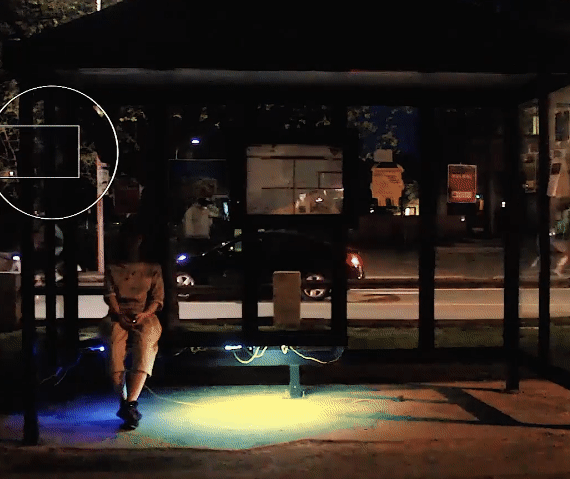BREATHING LIGHT
Harvard GSD VIS-2223: Digital Media I Spring 2018
Instructor: Allen Sayegh
Teammates: YinanLiu, JinmeiHu, MiaGuo, AllenCong
Project Overview
Starting from the Proxemics Theory, our proposal is to transform a bus station into a micro social space with the medium of light. The existing bus station locates in front of the memorial hall, functioning as a shelter for the people who wait for the bus. People come and go as time passes by. The transient is exaggerated with time subtlety but tremendously. We propose to visualize the transients with the assistant of light and time. This project enables us to see a space starting from us, growing around us, the overlapping with otherpeople’s space.By using Neopixel, Arduino, and photo-resistor sensors, we created a new installation with multiple lights affections. People in the bus station can claim their own color and space. The range of color will get larger and brighter through time. until one color mixes with another color, or in another sense, some one else’s space, it will keep going till lightening up the whole station. In this way, the light affections have become the new approach to communication and interaction.
Interpersonal Distance
The distance between people is subtle. It represents the degree of intimacy between people, as well as the spatial relationship of a group, a collective or even a society.
Proxemics
Edward T. Hall, the cultural anthropologist who coined the term in 1963, defined proxemics as "the interrelated observations and theories of humans use of space as a specialized elaboration of culture". He examines the various cultural concepts of space and how differences among them affect modern society. In his second book, The Hidden Dimension, he describes the culturally specific temporal and spatial dimensions that surround each of us, such as the physical distances people maintain in different contexts.
Site Investigation
The existing bus station locates in front of the memorial hall, functioning as a shelter for the people who wait for the bus. From 8:00 a.m. to 9:00 a.m., we recorded the crowd activities at the bus station. This time period is a crowded time for crowd activities. People get on and off buses and stop for a while at the station, then take the next bus to MIT or other Harvard campuses. We intercepted the period from 8:20 to 8:39 for visualization, in which people's activities changed four times. We use circles to express the time length people stayed at the station.
Design Concept
Our design concept is using the intensity and colors of light to show the time and space that such people stay at the bus station. First, we use different colors of light to represent each individual. The longer a person stays at a station, the greater the radiation range of light. Secondly, when different light interlaces each other, the color of light will change differently rather than simply overlay.
Design Detail
In order to visualize the transients with the assistant of light and time. We first put 4 photo-resistor sensors to sense people’s motion and location. And then by using Neo-pixel and LED belts, we created a new installation with multiple lights affections. People in the bus station can claim their own color and space. The range of color will get larger and brighter through time.
Different Scenarios
One color will mix with another color, or in another sense, some one else’s space, it will keep going till lightening up the whole station. In this way, the light affections will become the new approach for communication and interaction. This project enables us to see a space starting from us, growing around us, the overlapping with other people’s space.
Design Prototype
In order to visualize the transients with the assistant of light and time. We first put 4 photo-resistor sensors to sense people’s motion and location. And then by using Neo-pixel and LED belts, we created a new installation with multiple lights affections.
We made many tests before designing the final circuit. By using different sensors such as ultrasonic sensor, infrared sensor and photo-resistor sensor we tested different reactions along time changing.
Finally we find the best solution that the light can reflect people’s motion time to time. People in the bus station can claim their own color and space. The range of color will get larger and brighter through time. One color will mix with another color, or in another sense, some one else’s space, it will keep going till lightening up the whole station.
Onsite Test
So far, there are considerable studies relating to how colors impact on human’s mood, feelings, and behaviors. Hence, colors have to be considered significant in relating to human activities and interactions. Our design uses color to define the hidden space between people, so as to strengthen the communication between people in reality. On the other hand, color has become a container for the time that people stay in a certain environment, recording people's activities at different places.























